“A Guide of Spirits teaches us how to guide the dying to the land of the ancestors in a way that is balancing and healing. It teaches us how to hep the person who is transitioning energetically and spiritually prepare for their final journey to the afterlife. Chris Allaun also shows the witch and healer how to escort earthbound spirits to the ancestral lands so they may find healing and rejuvenation.”
– Book Blurb
Note: This book was sent to me by the publisher (Moon Books) for free in exchange for an honest review. All thoughts in this review are mine alone.

I was really excited to receive A Guide of Spirits by Chris Allaun. Working with the dead and my ancestors is something I’m actively learning about and incorporating into my daily practice. However, this book fell flat for me and I honestly couldn’t finish it. Even though I didn’t finish it, I still wanted to give my thoughts on the parts of the book I did happen to make it through. As you read the review, please keep that in mind.
I ended up making it through two and a half chapters. That’s not much, really, but the book only has nine chapters, and chapter three is fairly long. Right off the bat, I didn’t really vibe with the writing style. This is, of course, personal preference and nothing against the author themselves. Some phrases were worded a bit strange for me and I had to ask an outside source familiar with Greek mythology for clarification. That part in question is here.
“Once Hermes guides the spirits of the dead down into the Underworld, Charon takes them to the river Acheron. In Roman mythology the river is called Styx.” (pg. 29)
This particular quote made me scratch my head a bit because it makes it sound like Acheron is the only river in Greek myth while Styx is the only river in Roman myth. I have since learned (Thanks Fel!) that there are many rivers in the Underworld in Greek mythology, River Styx included, whereas all of these Underworld rivers in Roman mythology are given the same name of Styx.
Other than some oddly worded phrases, the rest of the book that I read and flipped through seems very New Age to me. There are also some red flags with what the author has said and purports to do, though they are red flags and I don’t have any further proof on the matter. Some of these red flags include the use of the word “shaman” and “shamanism”, promotion of the use of white sage and smudging, and the notion that “the transition into death is a beautiful experience…” (pg. 13). There are also a lot of blanket statements that are made and appear to generalize the entirety of paganism. One of those such statements is that “in paganism, the afterlife is seen as the realm of the ancestors” (pg.14).
One other thing that makes me suspicious is that the author claims to be a “Native American Pipe Carrier” (per his website), yet I can’t find any information on what that means for the author or which tribe he’s speaking of. As far as I know (and I may be wrong about this), there are several different Indigenous Nations that give importance to a Pipe Carrier, and they all vary in their beliefs, traditions, and responsibilities. For example, one website I found for the Mi’kmaw Nation, says that “In the Mi’kmaw tradition, a Pipe Carrier is born to the task. There is no way to earn this privilege – it is something you were given before you arrived on this Earth.” (Mi’kmaw Spirit) I was able to find some information about the author’s practice and history through another blog and web search but isn’t very clear. This may just be my skeptical mind being a bit too skeptical. Either way, the recommendation of smudging without specifying that it is an Indigenous Ceremony only seems to further encourage cultural appropriation.
To me, this book very much reads like that TV show Ghost Whisperer. The author is helping the deceased spirits that haven’t crossed into the Land of the Ancestors, as he calls it. He does this by energetically healing the parts of the person’s spirit that need healing so they can move on and be with their family on the other side. I’m not sure about the parts I didn’t get to, but the beginning chapters very much focus on loving energy. There is also a random mention of chakras in chapter five after no previous mention of chakras. I do like that there is quite a large resources section at the back of the book. However, there aren’t any in-text citations to point to certain material.
I won’t tell anyone not to read this book, but if you do, my only advice is to read it with a discerning lens. Personally, I will be donating my copy to my local library. This book just wasn’t for me.
Don’t forget to follow me on social media and subscribe to my newsletter.
Facebook| Instagram| Pinterest | YouTube | Newsletter



Leave a Reply